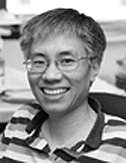| Home | |
| Faculty | |
| Graduate Program | |
| Events and Seminars | |
| Resources | |
| Contact Us | |
|
F A C U L T Y P R O F I L E
Current Research Dr. Qian's laboratory focuses on computational and psychophysical studies of neural systems. For example, the lab has constructed binocular vision models by analyzing known spatiotemporal receptive-field properties of visual cortical cells, and has applied the models to explain depth perception from horizontal disparity (stereovision), vertical disparity (the induced effect), inter-ocular time delay (the Pulfrich effects), motion field (structure-from-motion), and monocular occlusion (da Vinci stereopsis). The lab has also tested new predictions from the models via visual psychophysical experiments. A recent research direction is psychophysical investigation of faces. Face perception is essential for social interactions. While traditional face studies have primarily focused on high-level properties, Dr. Qian's lab has taken a complementary approach by investigating contributions of low-level processing along multiple, interactive streams to face perception. Another recent research direction is computational modeling of motor control and sensorimotor integration. In particular, the lab is interested in constructing stochastic optimal feedback control models that predict movement duration as well as trajectory. Finally, Dr. Qian's lab has been conducting theoretical and psychophysical studies of psychiatric disorders such as autism and schizophrenia. The goal is to gain a deeper understanding of the neural computation underlying these disorders and to use the information to improve therapy.
Selected Publications Qian, N. and Dayan, P. (2013) The Company They Keep: Background Similarity Influences Transfer of Aftereffects from Second- to First-order Stimuli. Vision Research, 87, 35-45. Qian, N. , Jiang, Y., Jiang, Z. P., and Mazzoni, P. (2013) Movement duration, Fitts's law, and an infinite-horizon optimal feedback control model for biological motor systems. Neural Computation, 25, 697-724. Xu, H., Liu, P., Dayan, P., and Qian, N. (2012) Multi-level visual adaptation: Dissociating curvature and facial-expression aftereffects produced by the same adapting stimuli. Vision Research, 72, 42-53. Qian, N. and Lipkin, R. M. (2011) A learning style theory for understanding autistic behaviors. Frontiers in Human Neurosci, 5:77. Xu, H., Dayan, P., Lipkin, R.M., and Qian, N. (2008). Adaptation across the cortical hierarchy: low-level curve adaptation affects high-level facial-expression judgments. J Neurosci 28, 3374-3383. Tanaka, H., Krakauer, J.W., and Qian, N. (2006). An optimization principle for determining movement duration. J Neurophysiol 95, 3875-3886.
|

